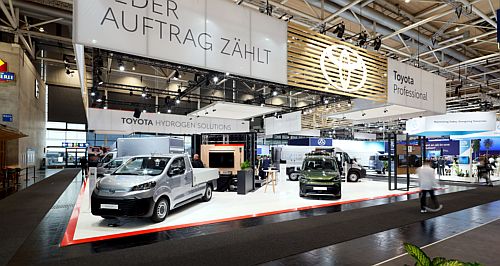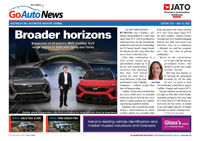Make / Model Search
Future models - Toyota - ProfessionalToyota shows new Euro LCV range at IAAProfessional Toyotas provide solution for short-haul European transport industry18 Sep 2024 TOYOTA used IAA Transportation 2024 in Germany (formerly Hannover Truck Show) to display its new heavy-duty van, full Professional line-up and hydrogen-based European Light Commercial Vehicle (LCV) “solutions” for the transport industry.
Presenting the automaker’s European strategy in the space(s) was Tom Fux, Toyota Motor Europe vice president, sales and value chain, and Toyota sales and marketing who said: “Our global company vision of providing mobility solutions for every customer and leaving no one behind also applies to our commercial vehicle range”.
Mr Fux announced that Toyota now offers a full and electrified product range to meet every customer’s need.
He channelled Toyota’s commercial vehicle business in Europe so far that dates from the 1960s when the burgeoning Japanese manufacturer launched the “legendary” HiLux ute and HiAce van in Europe each vehicle gaining a worldwide reputation since for quality, durability and reliability.
He reminded those attending that in 2016, Toyota entered a strategic partnership with Stellantis for commercial vehicles, starting with the Toyota ProAce. Since then, the automaker has enjoyed year-on-year growth in Europe, both in terms of sales and market share.
Mr Fux said Toyota strengthened its product line-up with the ProAce City at the end of 2019 and in 2021, introduced the ProAce and ProAce City Electric resulting in record sales last year of 140,000 units or a market share of 5.7 per cent.
That was on the back of selling HiLux ute and the ProAce entrants in the CDV and MDV van segments representing some 70 per cent of the entire European LCV market...
It left a 30 per cent market gap (the heavy-duty segment) out of reach but now it is covered off following the introduction of a newcomer to Toyota Europe’s range… the ProAce Max with a wide range of body varieties providing new business opportunities for Toyota and its customers.
The model has been shortlisted for the 2025 International Van of The Year.
It serves to kindle Toyota’s ambitions as it wants Toyota Professional to become an even more credible LCV brand in Europe… aiming for a top six position by further growing its market share to seven per cent and reaching an annual sales volume of 180,000 units.
“To achieve these goals, we have developed a Toyota LCV strategy encompassing a strong and competitive product range, enhanced customer care, market-leading commercial vehicle services and expertise and a dedicated product roll-out for Toyota Professional Centres across Europe to provide the right customer journey,” said Mr Fux.
“The new ProAce Max completes the Toyota Professional line-up with the focus now on customers who are in line to enjoy additional benefits such as a one-year warranty extension when the vehicle is serviced through an authorised Toyota retailer, an Express Service using two technicians and tailor-made financial services and products provided by Kinto, Toyota Financial Services and Toyota Insurance Services.
“In line with our Mobility for All promise, we have developed a wheelchair accessible vehicle conversion for ProAce Verso, and today, making a European premiere, we showcase a wheelchair accessible concept for the CDV segment as well.
“We will have the right products, the right services, and the right people, but also the right place with our Toyota Professional Centres to meet every customer needs. Our Toyota Professional Centres will all get a brand new, distinctive look. And by end of 2025 we are planning to reach 500 Toyota Professional Centres around Europe.”
Toyota has a multi-path strategy towards carbon neutrality, including in its commercial vehicle range, exemplified by the current fleet that offers customers a wide range of internal combustion engines, mild hybrid, and battery electric vehicles.
With a battery electric vehicles sales mix of 10 per cent Toyota is already a top performing brand in Europe, outperforming the market overall.
But its ambition is to further increase the mix of zero-emission vehicles by further working with customers to define the next generation of product solutions that includes battery electric and fuel cell electric prototypes of the iconic HiLux.
Mr Fux said he believes the fuel cell variant is of key interest in Europe.
In relation to Hydrogen fuel cell technology, Toyota Motor Europe’s executive vice president, R&D, hydrogen factory Europe, Shinichi Yasui said Toyota strongly believe that hydrogen fuel cell technology is a great fit for LCVs and “we recently demonstrated it in the Hilux at the Olympic games”.
“In fact, in Paris we showed how hydrogen can be used for many applications – all of which can support a local hydrogen cluster – which in turn creates demand and reduces costs. This kind of cluster combines fuel cell use in cars, taxis, buses, trucks and even boats operating on the river,” he said.
“Our goal is to reduce carbon emissions as much as possible, as soon as possible, everywhere in the world! And not just for light duty vehicles. We believe fuel cell technology is a very good fit for medium and heavy-duty transportation solutions.
“The wider use of hydrogen as an energy carrier is coming quickly. An EU regulation is coming to stimulate the development of a hydrogen refuelling infrastructure. This means there will be a hydrogen station every 200km along the Trans-European Transport Network by the end of this decade.
“The point is that green hydrogen is going to be widely available across Europe by 2030. Things are moving.”
Toyota believe that today it already has industry-leading hydrogen fuel cell technology recently announcing its third-generation technology which will further improve efficiency by around 20 per cent and reduce the cost of the fuel cell stack by up to 50 per cent.
“The launch of this latest technology will coincide with new infrastructure and green hydrogen developments I just mentioned,” added Mr Yasui.
“This will give an increasing number of transportation companies a practical and affordable way to reduce their carbon footprints.
“With our partners we have already created a wide range of applications including buses, boats, trains and stationary power generators.”  Read more29th of August 2024  BMW and Toyota tighten hydrogen tiesHydrogen fuel cell collaboration gets upgraded as BMW, Toyota study next-gen models18th of June 2024  Hydrogen HiLux reaches final test phaseFinal testing phase for hydrogen fuel cell HiLux with real-world trials underwayAll future models Alfa Romeo Alfa Romeo Abarth Abarth Alpine Alpine Alpina Alpina Audi Audi Aston Martin Aston Martin BMW BMW Bentley Bentley Chery Chery Brabham Brabham Chrysler Chrysler Chevrolet Chevrolet Cupra Cupra Citroen Citroen DS DS Dodge Dodge Fiat Fiat Ferrari Ferrari Foton Foton Ford Ford Great Wall Great Wall FPV FPV Haval Haval GWM GWM Honda Honda Holden Holden Hummer Hummer HSV HSV Infiniti Infiniti Hyundai Hyundai Jaguar Jaguar Isuzu Isuzu Kia Kia Jeep Jeep Land Rover Land Rover Lamborghini Lamborghini Lexus Lexus LDV LDV Mahindra Mahindra Lotus Lotus Mazda Mazda Maserati Maserati Mercedes-AMG Mercedes-AMG McLaren McLaren MG MG Mercedes-Benz Mercedes-Benz Mitsubishi Mitsubishi Mini Mini Opel Opel Nissan Nissan Peugeot Peugeot Pagani Pagani Proton Proton Porsche Porsche Renault Renault Ram Ram Rover Rover Rolls-Royce Rolls-Royce Skoda Skoda Saab Saab SsangYong SsangYong Smart Smart Suzuki Suzuki Subaru Subaru Toyota Toyota Tesla Tesla Volvo VolvoMotor industry news |
Click to shareToyota modelsResearch Toyota All future models Alfa Romeo Alfa Romeo Abarth Abarth Alpine Alpine Alpina Alpina Audi Audi Aston Martin Aston Martin BMW BMW Bentley Bentley Chery Chery Brabham Brabham Chrysler Chrysler Chevrolet Chevrolet Cupra Cupra Citroen Citroen DS DS Dodge Dodge Fiat Fiat Ferrari Ferrari Foton Foton Ford Ford Great Wall Great Wall FPV FPV Haval Haval GWM GWM Honda Honda Holden Holden Hummer Hummer HSV HSV Infiniti Infiniti Hyundai Hyundai Jaguar Jaguar Isuzu Isuzu Kia Kia Jeep Jeep Land Rover Land Rover Lamborghini Lamborghini Lexus Lexus LDV LDV Mahindra Mahindra Lotus Lotus Mazda Mazda Maserati Maserati Mercedes-AMG Mercedes-AMG McLaren McLaren MG MG Mercedes-Benz Mercedes-Benz Mitsubishi Mitsubishi Mini Mini Opel Opel Nissan Nissan Peugeot Peugeot Pagani Pagani Proton Proton Porsche Porsche Renault Renault Ram Ram Rover Rover Rolls-Royce Rolls-Royce Skoda Skoda Saab Saab SsangYong SsangYong Smart Smart Suzuki Suzuki Subaru Subaru Toyota Toyota Tesla Tesla Volvo VolvoMotor industry news |











Facebook Twitter Instagram